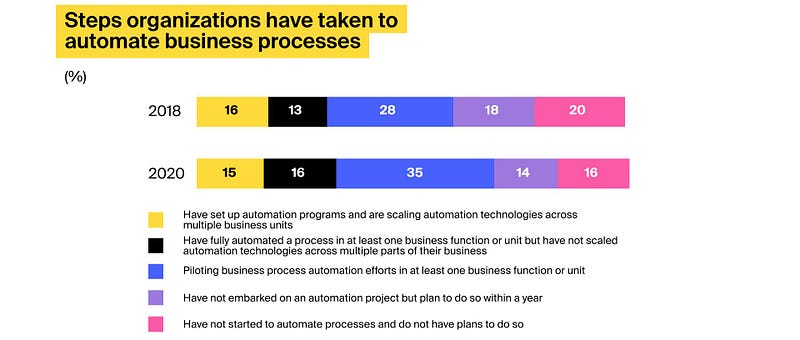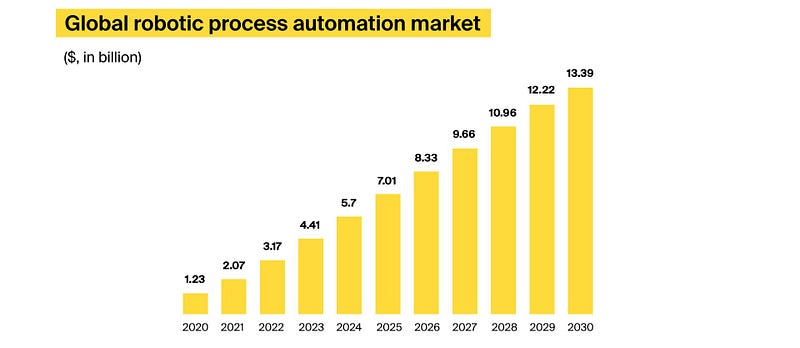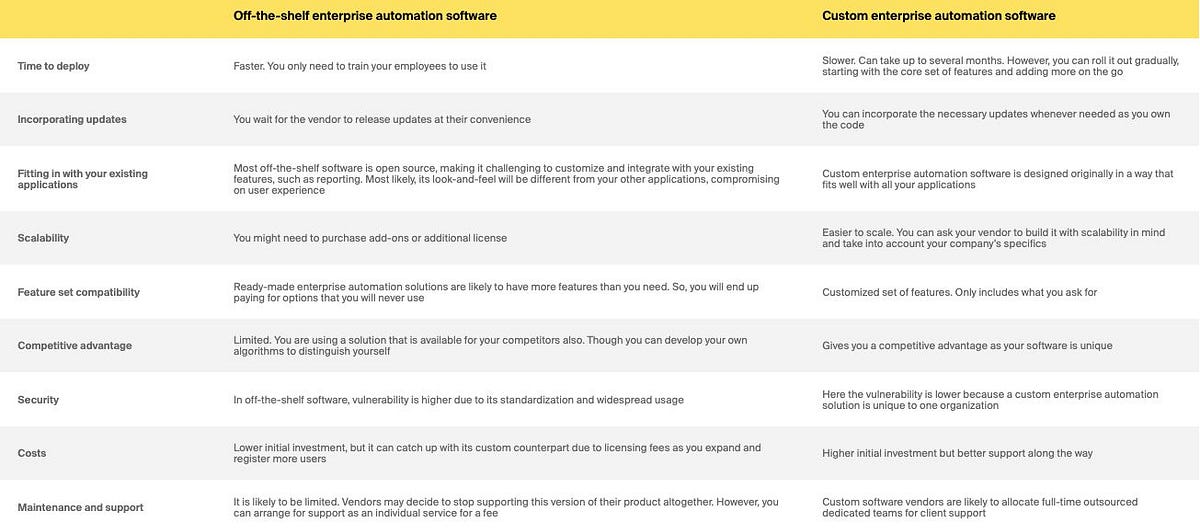Terry Wilson on November 10, 2021
You’ve probably noticed this trend of automating tasks, processes, and even complete departments. Maybe, your company is also considering implementing an intelligent process automation solution, but you still haven’t found the answer to the following questions:
- Do I build a custom system or opt for an off-the-shelf solution?
- Do I need to prepare my organization for a digital overhaul? If yes, where do I start?
In this article, ITRex CEO Vitali Likhadzed explains what ready-made and custom enterprise automation solutions can offer and which might better suit your business needs. Vitali also gives tips on getting started with automation and warns of challenges to expect on the way.
What is enterprise automation, and how does it help your company?
Definition and terminology clarification
Enterprise automation is defined by Integrify as a systematic review of an organization’s processes to ensure optimal performance while looking for manual processes that can be replaced with digital alternatives.
For the sake of terminology clarification, robotic process automation (RPA) and business process automation (BPA) are technologies one can use in enterprise automation. BPA focuses on streamlining complete processes and workflows across the organization, while RPA is responsible for automating individual tasks.
Here is what these concepts mean:
UiPath, a prominent RPA vendor, defines enterprise robotic process automation (RPA) as a software technology that makes it easy to build, deploy, and manage software robots that emulate human actions when interacting with digital systems. Software robots can do things like figuring out what’s on the screen, completing the right keystrokes, navigating systems, identifying and extracting data, and performing a wide range of defined actions.
Gartner defines business process automation (BPA) as the automation of complex business processes and functions beyond conventional data manipulation and record-keeping activities, usually through the use of advanced technologies. BPA focuses on “run the business” as opposed to “count the business” types of automation efforts and often deals with event-driven, mission-critical, core processes.
Intelligent enterprise automation enhances the traditional RPA’s capabilities with innovative artificial intelligence (AI)-based technologies , such as natural language processing (NLP), and computer vision.
Intelligent enterprise automation can use one or a combination of these technologies to offer complex, innovative solutions.
COVID-19 accelerates enterprise workflow management efforts
Deloitte and McKinsey, both reputable consultancy firms, conducted surveys that proved the pandemic forced companies to rethink the way they work. McKinsey research shows that the percentage of respondents taking action on automation has increased from 57% in 2018 to 66% in 2020.

Source: McKinsey & Company
During the same period, Deloitte questioned 441 executives from 29 countries to find that 73% of the respondents had already deployed automation technologies, such as machine learning and robotics. This number is up from 58% in 2019. Enterprise automation will continue its steady rise throughout the following decade. For example, according to Statista, the global robotic process automation market is predicted to surpass $13 billion by 2030.

Source: Statista
Enterprise workflow automation benefits
In one of its enterprise process automation projects, ITRex helped digital networking and booking services company to build a healthcare RPA solution. This product synchronizes patient appointment data between the company’s booking service and the electronic medical record systems (EMRs) of the company’s clients. Before deploying enterprise automation solutions, doctors wasted valuable time entering their availability data into various EMRs to give patients an accurate overview. This caused errors and frustration. To resolve this, the client employed ITRex to develop an automation healthcare system that would synchronize the client’s booking service with eClinicalWorks (eCW), one of the most popular EMR solutions in the US.
Even though this automation effort was limited in scope, it already brought the following benefits:
- Making the client’s booking service consistent with the eCW without modifying its internal code
- Eliminating human error
- Freeing up doctors’ time to take over more appointments instead of wasting time on data entry
- Reducing costs, as the client didn’t need to hire specialized eCW developers, who are relatively expensive. Neither did they pay eCW API fees
Off-the-shelf enterprise automation software vs. custom enterprise automation
Off-the-shelf (ready-made, packaged, etc.) software is a commercially offered and licensed digital product that you can deploy at your company for a monthly or annual fee. In contrast, custom solutions are designed and built catering to the requirements of a specific client. It is worth mentioning that some ready-made solution vendors are open to working with clients and customizing their offerings to fit into the client’s system. Below are the main differences between the two options. Disclaimer: this comparison is applicable in many cases. However, there can be exceptions, especially when speaking of customizing off-the-shelf solutions.

Off-the-shelf enterprise automation tools are more suited for:
- Enterprises operating in heavily-regulated industries. In this case, packaged software might already come compliant so that you don’t have to investigate and apply these regulations yourself.
- Large companies. If large businesses want to implement enterprise-wide automation, it is best to turn to off-the-shelf solutions. Custom enterprise workflow management software would be too expensive, time consuming, and might not cover all the variable use cases. Ready-made products, on the other hand, are designed for this type of client. Additionally, vendors receive user feedback and improve their systems accordingly.
Note: if you are a large enterprise that wants to automate only distinct tasks and use cases, feel free to turn to custom software solutions.
- Business cases with no special requirements where a standard set of features is sufficient.
Turning to an RPA consultant to build a custom enterprise automation software is worth considering under the following conditions:
- Projects with limited automation scope, when three to five use cases are considered
- Business cases that are unique and complex, where off-the-shelf products would need customization
- Legacy systems are involved
- Enterprises with rigid processes that can’t be adapted

Getting started with enterprise workflow automation: tips and challenges
Vitali advises companies considering RPA or enterprise intelligent automation to prepare for this process across three pillars — governance, data and technology, and the human pillar. Companies can do this alone or together with their selected automation vendor.
Governance:
- Identify the problems your company is trying to solve. For example, a bank may realize 50% of their clients who submitted a personal loan application form end up withdrawing before a decision is made
- Outline use cases for enterprise automation and prioritize them. We can investigate the business problem mentioned above to discover concrete use cases. Here is one way to proceed. Why do 50% of our clients withdraw? Because they must wait for a prolonged period. Why is that? One reason is that our loan application review process requires approval from five people. Human approval is not something we can automate, so we keep searching further. Another reason is that loan officers need to access data from different systems to make a decision, and afterwards, they enter all the information in the bank’s system. Here is a viable use case — i.e., automating data collection and information input processes.
- Optimize business processes before automating. Make sure the process is as efficient as possible before you automate. In the loan application example, do we need the approval of five people? Maybe in some cases, three approvals are enough.
- Define clear business goals you want to achieve with enterprise automation. Coming back to the bank example, the goal is to spend less time processing loan applications and give an answer to the client before they withdraw their file and submit it to competitors.
- Highlight KPIs to measure the value of automation to the business. One example of the bank’s KPI can be making a decision on personal loan applications within one working day.
- Ensure executive leadership support. This will help you get other employees to cooperate even when the initiative causes inconveniences or fails to produce value immediately.
- Identify all the stakeholders involved in enterprise automation. These people can come from different departments and vary in their background and expertise. It is best to make sure their views on automation are aligned.
- Define risks. Here are some examples: (1) decreased loyalty among employees as they start experiencing job security fears (2) integration with legacy systems can take much longer than we anticipated originally, (3) this new automated system might open vulnerabilities from the security standpoint.
Data and technology:
- Choose the right technology for every business problem. If your company is small, the automation scope is modest, and the use cases are standard, then opt for a small-scale enterprise automation system that covers your needs. Nothing more.
- Leverage multiple technology solutions to bring end-to-end automation. In theory, it would be nice to have one platform across different departments. But if your business is fragmented, this will not be a viable option. Suppose you have one autonomous isolated (no Internet connection) department with a few straightforward requirements. In that case, a simple custom Python script might suffice, even if your other departments are using more complicated automation software.
- Select solutions that integrate well with the existing ecosystem. Your ecosystem has its established workflow, make sure the automation tool you choose is compatible with it and can integrate with your applications. Don’t trap yourself with a novel technology that doesn’t fit with your existing tech stack.
- Pay attention to data quality. Make sure the data you input and generate with this new enterprise automation solution is compliant with your overall data strategy.
Humans and change management:
- Ensure everyone understands automation goals. The new system will take over repetitive, dull tasks and allow employees to focus on what matters and devote more time to creative and strategic duties.
- Drive workforce transformation, not replacement, if possible. Automation is expected to eliminate as well as create new job opportunities. Research shows workforce automation can displace 85 million jobs in the coming years, but it is expected to create 97 million instead. Given this situation, it may be a wiser choice to reskill your employees.
- Invest in employee education. Train users on the new work environment and support them to facilitate adoption.
- Develop an HR strategy to retain employees and attract talent for critical roles. When a part of their everyday duties becomes automated, employees might feel there is no place for them in your company anymore. But this workforce has other key skills that the enterprise can’t afford to lose. This is where the HR department comes in. They need to find ways to keep these people motivated and interested in staying or quickly recruit a replacement if they insist on moving on.
- Establish an agile way of working. Employees need to be prepared to pivot within their job role, take other responsibilities, and be prepared to learn.
Ready to take action?
If after reading this article, you find yourself a perfect candidate for off-the-shelf enterprise automation tools, then go ahead and purchase one. It will be cheaper and faster than building a custom application. But if you want something unique and tailored to your processes and operations, then it’s a good idea to start searching for a vendor providing custom enterprise automation services. Be sure your vendor is familiar with your industry’s regulations and that he is willing to offer continuous support, help you scale, and introduce new features. The ITRex team will not only cover the points mentioned above but can also look beyond the traditional RPA into intelligent enterprise automation thanks to our expertise in AI and other related technologies.
Are you looking for a custom enterprise automation solution that fits into your system? Drop ITRex consultants a line! Together, you can build something really unique.
Collected at: https://datafloq.com/read/how-to-get-started-enterprise-automation/19240
